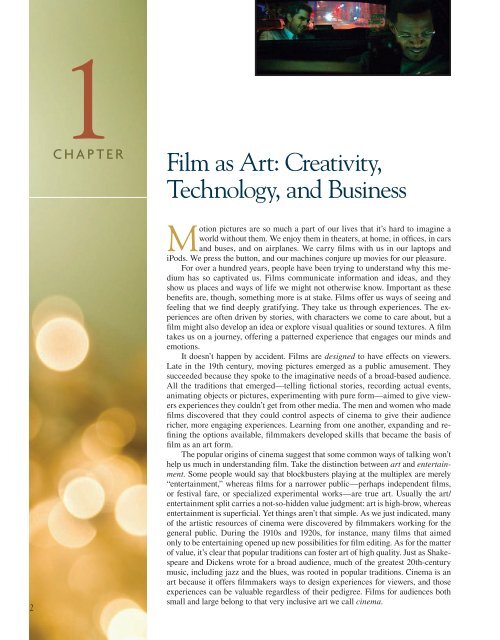Film Art and Filmmaking
Film Art and Filmmaking
Film Art and Filmmaking
You also want an ePaper? Increase the reach of your titles
YUMPU automatically turns print PDFs into web optimized ePapers that Google loves.
2<br />
2<br />
1<br />
CHAPTER<br />
<strong>Film</strong> as <strong>Art</strong>: Creativity,<br />
Technology, <strong>and</strong> Business<br />
Motion pictures are so much a part of our lives that it’s hard to imagine a<br />
world without them. We enjoy them in theaters, at home, in offi ces, in cars<br />
<strong>and</strong> buses, <strong>and</strong> on airplanes. We carry fi lms with us in our laptops <strong>and</strong><br />
iPods. We press the button, <strong>and</strong> our machines conjure up movies for our pleasure.<br />
For over a hundred years, people have been trying to underst<strong>and</strong> why this medium<br />
has so captivated us. <strong>Film</strong>s communicate information <strong>and</strong> ideas, <strong>and</strong> they<br />
show us places <strong>and</strong> ways of life we might not otherwise know. Important as these<br />
benefi ts are, though, something more is at stake. <strong>Film</strong>s offer us ways of seeing <strong>and</strong><br />
feeling that we fi nd deeply gratifying. They take us through experiences. The experiences<br />
are often driven by stories, with characters we come to care about, but a<br />
fi lm might also develop an idea or explore visual qualities or sound textures. A fi lm<br />
takes us on a journey, offering a patterned experience that engages our minds <strong>and</strong><br />
emotions.<br />
It doesn’t happen by accident. <strong>Film</strong>s are designed to have effects on viewers.<br />
Late in the 19th century, moving pictures emerged as a public amusement. They<br />
succeeded because they spoke to the imaginative needs of a broad-based audience.<br />
All the traditions that emerged—telling fi ctional stories, recording actual events,<br />
animating objects or pictures, experimenting with pure form—aimed to give viewers<br />
experiences they couldn’t get from other media. The men <strong>and</strong> women who made<br />
fi lms discovered that they could control aspects of cinema to give their audience<br />
richer, more engaging experiences. Learning from one another, exp<strong>and</strong>ing <strong>and</strong> refi<br />
ning the options available, fi lmmakers developed skills that became the basis of<br />
fi lm as an art form.<br />
The popular origins of cinema suggest that some common ways of talking won’t<br />
help us much in underst<strong>and</strong>ing fi lm. Take the distinction between art <strong>and</strong> entertainment.<br />
Some people would say that blockbusters playing at the multiplex are merely<br />
“entertainment,” whereas fi lms for a narrower public—perhaps independent fi lms,<br />
or festival fare, or specialized experimental works—are true art. Usually the art/<br />
entertainment split carries a not-so-hidden value judgment: art is high-brow, whereas<br />
entertainment is superfi cial. Yet things aren’t that simple. As we just indicated, many<br />
of the artistic resources of cinema were discovered by fi lmmakers working for the<br />
general public. During the 1910s <strong>and</strong> 1920s, for instance, many fi lms that aimed<br />
only to be entertaining opened up new possibilities for fi lm editing. As for the matter<br />
of value, it’s clear that popular traditions can foster art of high quality. Just as Shakespeare<br />
<strong>and</strong> Dickens wrote for a broad audience, much of the greatest 20th-century<br />
music, including jazz <strong>and</strong> the blues, was rooted in popular traditions. Cinema is an<br />
art because it offers fi lmmakers ways to design experiences for viewers, <strong>and</strong> those<br />
experiences can be valuable regardless of their pedigree. <strong>Film</strong>s for audiences both<br />
small <strong>and</strong> large belong to that very inclusive art we call cinema.

















